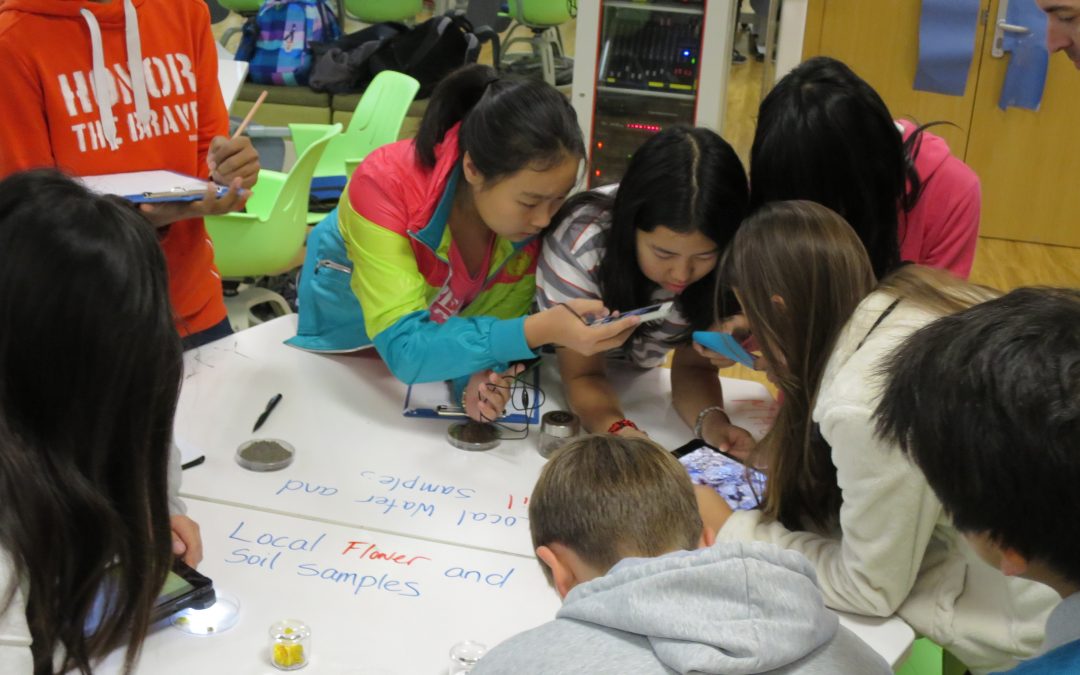Happy start of April!
Can you find the teacher in the picture above??
This isn’t an April fools joke. There is definitely a teacher if you look closely enough; just not in their traditional form. Instead, the teacher appears in the form of a small petri dish and accompanying questions.
“What do you notice in these samples?”
Students are using the IPADs to zoom in on local water, soil and flower samples.
It’s one of six learning stations placed strategically around the room to help students investigate their local ecosystem.
Other ‘teachers’ come in the form of maps, asking students to identify sources of local waterways.
Short videos, teaching students the human and non-human influences on water borne ecosystems.
Each station provides an activity and open-ended questions for students to respond to publicly on movable whiteboards.
If you zoom out, you can find the human teacher. He moves around freely to manage rotations; pose probing questions; stimulate informal conversations; answer student inquiries; and clear up misconceptions.
This is what a student- centered classroom looks like when it shifts from…

How might learning stations like these work in your context?
Here are five quick tips for developing and running them:
- Pose simple, open-ended questions: In response to the learning station photo, video, short excerpt, activity etc. ask student open-ended questions. What do you notice? What do you wonder? What puzzles you? What do you think…
- Make student responses visible: Use movable whiteboards, writable surfaces, or large butcher paper for student’s to share thinking, and interactive with others’ responses. I also recommend using post-it notes so you can move responses according to emerging themes.
- Place students into strategic groups: Have students rotate from station to station with peers that will help support thoughtful, critical dialogue. Keep group size from 4-6 students (4-6 stations) to foster more interaction.
- Make stations ACTIVE: Stations should ask students to do something…zoom in on a photo, piece together a puzzle, build a shape, locate certain features, etc. Making stations active will increase engagement and stimulate an environment that invites curiosity and wonder.
- Use peer leaders to run stations: This one is optional but very helpful. Prior to creating station based learning, consult with strong leaders to ‘man’ the stations. These leaders can help explain the station’s objectives and foster meaningful interaction within the station.
Station based learning can work for ALL subjects, and does two very important things that are absolutely critical for student-centered environments:
A. Stimulates critical thinking and student inquiry
B. Helps you to move from a Teacher into a FACILITATOR role
How might station-based learning work in your context?
While I have your attention. Pre-order my new book…
The examples provided above are only a few of SEVERAL more shared in my new book, “Where is the Teacher: The 12 shifts for student-centered environments” scheduled for release in August!
There are 40+ stories.
50+ strategies.
And unquantifiable inspiration to help you shift from a Teacher-Led – – – > Student-Centered Environment in the 2024-2025 school year.
And right now it’s available for pre-order! Click on the book image below to read the free introduction and pre-order your copy:

www.transformschool.com/whereistheteacher
Have a great student-centered 1st week of April!
